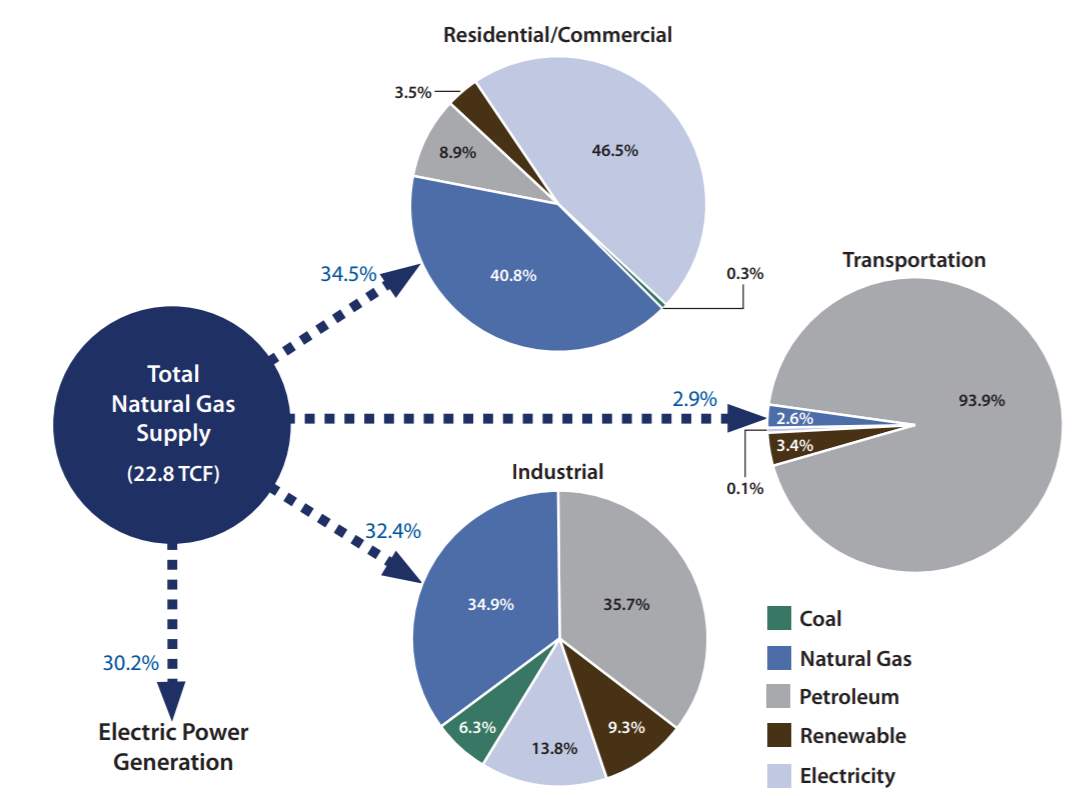What is the Importance of Organic Chemistry to Society?
| ✅ Paper Type: Free Essay | ✅ Subject: Chemistry |
| ✅ Wordcount: 1850 words | ✅ Published: 18 May 2020 |
Natural gas
Natural gas is primarily methane (CH4) with smaller quantities of other hydrocarbons, commonly including varying amounts of other higher alkanes, it can be an only small percentage of carbon dioxide, nitrogen, hydrogen sulfide, or helium. The natural gas can be categorized as dry that it’s mostly methane and wet that contains compounds such as ethane and butane in addition to methane. It is a colorless, odorless gas that occurs abundantly in nature and as a product of certain human activities. Through this report, it will elucidate how critical is natural gas in our life as a society.



Figure 1: Countries by natural gas reserves.
Chemical structure
The chemical structure of methane
in which is specialized with its single bonding that formed this structure:

Figure 2: chemical structure of methane.
The production of methane
The production of methane occurs in four stages:
- Biogas production:
The production of biogas from organic material under anaerobic conditions involves a sequence of microbial reactions. During the process complex, an organic molecule present in the biomass is broken down to sugar, alcohols, pesticides and amino acids by acid-producing bacteria. The resultant products are then used to produce methane by another category of bacteria. The biogas production includes three stages: Hydrolysis, Acid formation, and Methane formation.
The degradation process can be achieved for organic material in several steps through the use of a range of bacteria, which are specialized in the reduction of intermediate products formed. The efficiency of the digestion depends on how far the digestion happens in these three stages. Better the digestion, shorten the retention time and efficient gas production.
- Hydrolysis (Polymer breakdown) stage:
The complex organic molecules like fats, starches, and proteins which are water-insoluble contained in cellulosic biomass are broken down into simple compounds with the help of enzymes secreted by bacteria. The major product is glucose which is a simple product.
- Acid formation stage:
Products produced in the Hydrolysis stage are fermented under anaerobic conditions to form different acids. The major products produced at the end of this stage are acetic acid, propionic acid, butyric acid, and ethanol.
- Methane formation stage:
The acetic acid produced in the previous stages is converted into methane and carbon dioxide by a group of “microorganisms” called “Methanogens”. However, it is the process of production of methane by methanogens. They are obligatory anaerobic and too sensitive to environmental changes. Methanogens utilize the intermediate products of the preceding stages and convert them into methane, carbon dioxide, and water. It is these components that make up the majority of the biogas emitted from the system.
Sabatier reaction: It involves the reaction of hydrogen with carbon dioxide at elevated temperatures (optimally 300–400 °C) and pressures in the presence of a nickel catalyst to produce methane and water.

Figure 3: Other stages of production of methane.
Benefits of Natural gas (methane)
Methane and in addition to other compounds that make the natural gas have many benefits to the society such as: make refrigerants and to produce products like plastics. Natural gas is largely used for domestic or industrial heating and to generate electricity. It can also be compressed and used to fuel vehicles and as a feedstock for fertilizers hydrogen fuel cells and other chemical processes. The properties of the natural gas are used because of its:
- The cleanest fuel available today: natural gas is called clean because it emits 50 percent less carbon dioxide than coal when you burn it. It’s cleaner than coal. It’s better than the worst (cleaner than coal). The reaction of combustion is what releases energy which reacts rapidly with oxygen. this combustion method consists of a reaction between methane and oxygen within the air. Once this reaction occurs, the result is carbon dioxide (CO2), water (H2O), and a great deal of energy.

- Able to compete with other energy sources: Domestic supplies of natural gas have increased dramatically in recent years, due in large part to the development and expansion of hydraulic fracturing (fracking) drilling techniques. This increased supply – which is expected to continue for years – has lowered prices for natural gas, making it very cost-competitive compared to other energy sources.
- Non-toxic – Lighter than air: Natural gas is non-toxic (non-poisonous) but can cause death by suffocation if the gas displaces the air in a confined space. It can affect the human the following effects as gas concentration increases:
- At 27 to 31% of gas in air, the oxygen deficiency can cause ringing ears, euphoria, and unexplained behavioral changes.
- At a 52% gas-air mixture, a person taking in a few breaths will be incapacitated and unable to self-rescue.
- At 73% of gas, a person is immediately incapacitated, and death will occur in a matter of minutes.
Natural gas is always lighter than air and will rise in a room if allowed to escape from a burner or leaking fitting. On the contrary, propane is heavier than air and will settle in a basement or other low level.
The advantages of using natural gas for society
- Economics used natural gas because it’s cheaper compared to other fossil fuels, and cheaper than electricity when used for supplying home appliances. In addition, it’s almost worldwide available.
- Transportation: it is made via sea and land (pipelines and small tanks). This fact would help to transfer from power plants to residential areas. Natural gas used in transportation can reduce greenhouse gas emissions by 20% – 30% when compared to petrol and diesel. Vehicles running on natural gas emit 25% less carbon dioxide than those powered by petrol, and 20% less carbon dioxide than those powered by diesel.
- Multi-uses: Natural gas is a multi-use fuel. It is used inside the houses such as for cooking and heating. It can be used for generating electric power, powering vehicles, producing plastics, paints, fertilizers, and many more uses.
- Renewable: Biogas facilities produce renewable gas mainly by fermenting biological waste such as plant waste. In countries with a large forestry sector, such as northern Europe countries, there is a high potential to produce Synthetic natural gas (SNG) from waste wood. By means of biomass gasification, synthesis gas is produced, which mainly consists of hydrogen, carbon monoxide, and carbon dioxide. This mix can then be converted into high-quality methane by methanation.
 Figure 4: Natural gas use 2017
Figure 4: Natural gas use 2017

Figure 5: Natural gas end-use markets (2009).
The disadvantages of using natural gas
- Flammable and Toxic: Natural gas leaks can be proven to be very dangerous. Such leaks may cause fire or explosions. The gas itself is extremely toxic when inhaled. The risk comes from the fact that it is naturally odorless and cannot be detected by smell unless an odorant has been added to the gas mixture.
- Environmental Impact: When natural gas burns, carbon dioxide, monoxide, and other carbon compounds are emitted in the atmosphere contributing to the greenhouse effect. Although it is cleaner than other fossil fuels (oil, coal, etc.). natural gas leaks can become more hazardous since methane is 21 times more dangerous than carbon dioxide. As a greenhouse gas, methane can affect global warming, in-depth, carbon dioxide emissions increase warming which melts ice, and releases methane into the air while causing oceans to rise. Methane cause more warming which melts more ice which releases more methane.
- Cost of the installation: The entire pipe establishment so expensive to develop since long pipes, specialized tanks, and separate pipes frameworks should be utilized. Pipe spillage may likewise be extravagant to identify and fix.
Political implication
Some of the most critical energy developments of recent years have been in the realm of natural gas. Gigantic quantities of unconventional U.S. shale gas are now commercially viable, changing the key picture for the United States by making it of independent inflammable gas for the next years. This development alone has resounded throughout the world, inflicting shifts in patterns of trade and leading other countries in Europe and Asia to explore their own shale gas potential. Such developments are putting pressure on long arrangements, such as oil-linked gas contracts and the separate nature of North American, European, and Asian gas markets, and may lead to strategic shifts, such as the weakening of Russia’s dominance within the European gas market.

Figure 6: Major trade movements in 2013.
Social cost
The cost of natural gas is affected by both internal and external factors. Internal factors include prices of purchase, transportation, storage, and production along with facility costs which include depreciation prices of natural gas infrastructure and costs of natural gas infrastructure development. External indicators include the price of energy (electricity, heat) and fuel such as fuel oil, distillates, coal, and local resources. In addition, using natural gas at home is cheaper than using electricity and can save about 42% from using natural gas and the and the carbon emissions will be 85% lower than those from electric appliances due to the high portion of electricity generated from coal power stations.

Figure 7: Internal and external factors of social cost.
Conclusion and Recommendations:
This report clarified the importance of using natural gas that includes methane and how natural gas affected the environment negatively but not worse than any energy source from fossil fuels. The natural gas has many uses in our daily life, but we still need to put a limit on using it because it takes a long term to produce it again, and how the people switched from using coal to natural gas. However, gas is by no means that a cure-all for the environmental issues caused by our energy use. There is broad agreement among climate scientists that carbon reductions of a minimum of 80% by 2050 are going to be required avert the worst effects of climate change. Simply switch to gas from coal and oil won’t ultimately cause mandatory reductions. attempts to capture and store the carbon dioxide emissions from fossil fuels have come to naught due to technical difficulties and high cost. Thus, to curtail global warming we need to replace fossil fuel use entirely. For the future, the world needs to have energy sources that don’t impact the environment negatively, be available and at low cost. Australia has the best solar energy resources in the world. This is because it is the continent with the largest solar radiation per square meter of any continent. That because of the desert in the center and northwest has one of the highest solar radiation in the world. The government can use this huge space to replace the use of natural gas with solar radiation and to demise the greenhouse emission.

Figure 8: Image of using solar radiation as energy source.
Bibliography
- (2008). Retrieved from wikipedia: https://en.wikipedia.org/wiki/Natural_gas
- (2009). Retrieved from bakerinstitute: https://www.bakerinstitute.org/center-for-energy-studies/geopolitics-natural-gas/
- (2010). Retrieved from brighthubengineering: https://www.brighthubengineering.com/power-plants/114797-pros-and-cons-of-natural-gas-use/
- (2011). Retrieved from pinedalegas: https://www.pinedalegas.com/natural-gas/hazards-of-natural-gas
- (2012). Retrieved from youtube: https://www.youtube.com/watch?time_continue=209&v=-njmj0diWu8
- (2015). Retrieved from pubs: https://pubs.rsc.org/en/content/articlelanding/2017/fd/c7fd00009j#!divAbstract
- (2018). Retrieved from ucsusa: https://www.ucsusa.org/clean-energy/coal-and-other-fossil-fuels/the-future-of-natural-gas
- opinionator. (2011). Retrieved from https://opinionator.blogs.nytimes.com/2013/09/24/is-natural-gas-clean/
- ucsusa. (2017). Retrieved from https://www.ucsusa.org/clean-energy/coal-and-other-fossil-fuels/infographic-climate-change-risks-natural-gas
Cite This Work
To export a reference to this article please select a referencing stye below:
Related Services
View allDMCA / Removal Request
If you are the original writer of this essay and no longer wish to have your work published on UKEssays.com then please click the following link to email our support team:
Request essay removal


